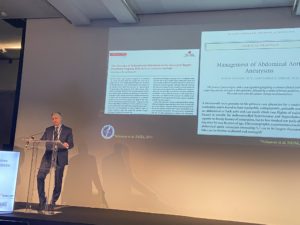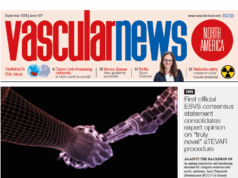
The US investigational device exemption (IDE) Aortic Research Consortium has produced the strongest data so far on the use of fenestrated/branched endovascular aneurysm repair (F/BEVAR), Andres Schanzer (University of Massachusetts, Worcester, USA) claimed at Critical Issues in Aortic Endografting 2021 (17–18 December, Paris, France). As a result of the group’s work, “more patients are getting better care, by more providers, using F/BEVAR devices,” he remarked, summarising key datasets presented since 2018.
The primary objective of the US F/BEVAR Aortic Research Consortium (US-ARC), first conceived of in 2018, is to evaluate custom-made fenestrated and branched endovascular devices for the treatment of patients with complex abdominal, thoracoabdominal and arch aneurysms, Schanzer detailed. He noted that, currently, the literature includes primarily iterative, single-centre reports, the findings of which “may be limited due to the potential for a type 1 error secondary to limited statistical power”. According to Schanzer, medical director of US-ARC, that is about to change, as the US-ARC includes prospective, physician-sponsored data from across 10 US sites and is independently monitored and FDA audited. Referencing an email he sent to investigators when initiating this effort in early 2018, Schanzer communicated: “If we are able to pull this off and figure out a way to aggregate our data in a relatively seamless way and work together as a team of investigators, I believe we have the potential to make a much more significant impact than multiple iterative, single-centre reports.”
Key datasets highlight growing pool of evidence
Members of the US F/BEVAR ARC have presented data on behalf of the consortium at several key conferences since 2018. The datasets started off small, Schanzer relayed. At the Society for Vascular Surgery (SVS) 2018 Vascular Annual Meeting (VAM; 20–23 June, Boston, USA), for example, Emanuel R Tenorio (University of Texas Health Science Center at Houston, Houston, USA) presented outcomes of endovascular repair of post-dissection and degenerative thoracoabdominal aortic aneurysms (TAAAs) using fenestrated and branched stent grafts. The study, which incorporated 240 patients, showed F/BEVAR to be safe and effective, with similar outcomes in patients with post-dissection and degenerative TAAAs, and also that patients with post-dissection had more type II endoleak during follow-up. Tenorio stressed that larger clinical experience and longer follow-up was needed to better evaluate differences in mortality, spinal cord injury, target vessel instability and secondary interventions.
At the same meeting, Schanzer recounted, Darren B Schneider (University of Pennsylvania, Philadelphia, USA) presented target artery outcomes after branched and fenestrated endovascular repair of pararenal aortic aneurysms and TAAAs in 661 patients. Schneider summarised that the selective use of fenestrations and directional branches for visceral artery incorporation is durable, that the risk of target artery instability is higher for renal versus mesenteric arteries, and that greater TAAA extent is associated with increased target instability. Future efforts, he informed the VAM audience, should focus on improving renal artery patency and reducing interventions.
Later that same year, Schanzer recalled that Carlos H Timaran (University of Texas Southwestern, Dallas, USA) gave evidence on the expanded use of preloaded branches and fenestrated endografts for endovascular repair of complex aortic aneurysms. Speaking at the 32nd European Society for Vascular Surgery (ESVS) Annual Meeting (24–28 September, Valencia, Spain), Timaran presented data on 564 patients, concluding that the expanded use of preloaded catheters and wires of fenestrations and directional branches for target artery incorporation is associated with even higher technical success and lower early mortality.
Schanzer then looked back to the 2019 VAM (12–15 June, National Harbor, USA), where he presented results of F/BEVAR after failed infrarenal EVAR in 893 patients. He noted that F/BEVAR was safe and effective in patients with prior failed EVAR, with nearly identical outcomes as compared to patients without prior EVAR, while differences in procedural metrics indicated higher level of technical challenge when performing F/BEVAR in patients with prior failed EVAR. The speaker concluded that F/BEVAR, at high-volume centres, is a viable option for the treatment of EVAR failure that compared favourably to historical reports of open conversion.
At the 33rd ESVS Annual Meeting (24–27 September, Hamburg, Germany) the following year, Fernando Motta (The University of North Carolina, Chapel Hill, USA) informed the audience that F/BEVAR is a safe and effective option for octogenarians in training complex aortic aneurysms compared to non-octogenarians, Schanzer detailed, outlining data from 893 patients.
Finally, Schanzer gave an overview of the largest US IDE Consortium dataset so far—a study on sex-related outcomes after F/BEVAR for TAAAs involving 1,681 patients. Announcing the findings during ESVS Month (29 September–29 October 2020, online), Matthew P Sweet (University of Washington, Seattle, USA) revealed that women experienced higher rates of technical failure for extensive aneurysms, non-home discharge and postoperative sac expansion.
A turning point for fenestrated and branched procedures
Addressing the Critical Issues audience, Schanzer summarised that the US F/BEVAR ARC is the largest dataset of fenestrated and branched procedures in the world, involving a core group of investigators “committed to improving patient care and pushing the envelope on endovascular therapies from the aortic valve to the common femoral artery”. The consortium is “an engine for exchange of ideas and promotion of F/BEVAR technologies,” the speaker continued, emphasising his hope that the group’s work will have an impact not just in the USA but across the globe.
On a more practical level, Schanzer added, the consortium “offers infrastructure and a more agile regulatory pathway for testing emerging technologies to obtain preliminary data,” and also represents a departure from single-centre reports. The project provides a framework in which to conduct randomised trials, Schanzer stressed, noting that the trajectory of F/BEVAR technologies has reached an “inflection point,” and that larger studies will henceforth reveal the direction of travel in this developing field.













